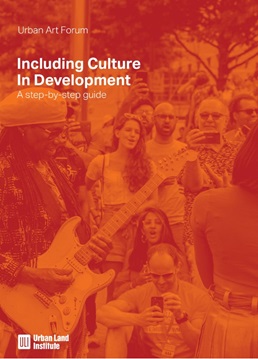Urban Art Forum: Including Culture in Development

A Step-by-Step Guide
The Urban Land Institute UK’s Urban Art Forum (UAF) has released its first publication, Including Culture in Development: A Step-by-Step Guide, following more than six months of research and development. Cultural placemaking has become a vital element for successful developments and is crucial for generating long-term economic and social return on capital investment. The guide provides clear and concise direction, along with effective methodology, and assists developers of the built environment to help improve the creation and integration of quality public art and cultural infrastructure within their schemes.
The step-by-step guide has been initially released as a London-focused publication, using case studies such as Somerset House Studios, the Creative Land Trust and Art Night along with select interviews – expanding on existing material such as the Greater London Authority’s ’Cultural Infrastructure Toolbox’. It establishes a methodology for best practice by identifying opportunities, goals, strategies and outputs for approaching a variety of factors such as timescale and intervention type.
By highlighting the objectives and roles within a particular project – those related to developers, cultural professionals, local authorities, local communities or design professionals – it provides a much-needed framework for developers and investors that highlights the benefits of incorporating cultural infrastructure and public art into their schemes.
The guide has been compiled with contributions from a range of highly-experienced culture and built environment professionals, including the Culture and Creative Industries Unit at the Greater London Authority, PLP Architecture, Futurecity, Sound Diplomacy, Contemporary Art Society and Launch Pad.
Author: Urban Land Institute
Book Summary: The Urban Land Institute UK’s Urban Art Forum (UAF) has released its first publication, Including Culture in Development: A Step-by-Step Guide, following more than six months of research and development. Cultural placemaking has become a vital element for successful developments and is crucial for generating long-term economic and social return on capital investment. The guide provides clear and concise direction, along with effective methodology, and assists developers of the built environment to help improve the creation and integration of quality public art and cultural infrastructure within their schemes.
The step-by-step guide has been initially released as a London-focused publication, using case studies such as Somerset House Studios, the Creative Land Trust and Art Night along with select interviews – expanding on existing material such as the Greater London Authority’s ’Cultural Infrastructure Toolbox’. It establishes a methodology for best practice by identifying opportunities, goals, strategies and outputs for approaching a variety of factors such as timescale and intervention type.
By highlighting the objectives and roles within a particular project – those related to developers, cultural professionals, local authorities, local communities or design professionals – it provides a much-needed framework for developers and investors that highlights the benefits of incorporating cultural infrastructure and public art into their schemes.
The guide has been compiled with contributions from a range of highly-experienced culture and built environment professionals, including the Culture and Creative Industries Unit at the Greater London Authority, PLP Architecture, Futurecity, Sound Diplomacy, Contemporary Art Society and Launch Pad.
Author: Urban Land Institute


